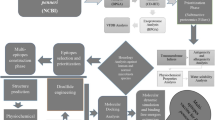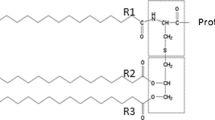Summary
Yersinia enterocolitica and Yersinia pseudotuberculosis are food-borne enterobacterial pathogens which may initiate rheumatoid diseases. By molecular genetic analysis of the pathogenicity of these species virulence gene loci could be identified on the chromosome and on a plasmid. Plasmidencoded proteins mediate cell adherence, phagocytosis resistance, survival in serum, cytotoxicity, and collagen binding. Y. enterocolitica of serotype 0 : 8 is mouse-lethal and arthritogenic for Lewis rats. Mouse lethality is closely associated with the expression of a chromosome-encoded high-affinity iron transport system which enables the pathogen to acquire iron for growth in iron-deficient environments. The antibody response to virulence-associated antigens of arthritis-susceptible Lewis rats differed from that of arthritis-resistant Fisher rats: Lewis rats respond strongly to the collagen-binding protein Yop1 and weakly to the iron-transport receptor protein FyuA, whereas the reverse is found with Fisher rats. This specific antibody response of Lewis rats is suggested to be important for induction of arthritis.
Similar content being viewed by others
References
Bottone EJ (1977) Yersinia enterocolitica. A panoramic view of a charismatic organism. CRC Crit Rev Microbiol 5:211–241
Knapp W (1958) Mesenteric adenitis due to Pasteurella pseudotuberculosis in young people. N Engl J Med 259:776–778
Ahvonen P, Sievers K, Aho K (1969) Arthritis associated with Yersinia enterocolitica infection. Acta Rheumatol Scand 15:232–253
Winblad S (1969) Erythema nodosum associted with infection with Yersinia enterocolitica. Scand J Infect Dis 1:11–16
Toivanen A, Granfors K, Lahesma-Rantala R, Leino R, Stahlberg T, Vuento R (1985) Pathogenesis of Yersinia-triggered reactive arthritis: immunological, microbiological and clinical aspects. Immunol Rev 86:47–70
Granfors K, Viljanin M, Tiilikainen A, Toivanen A (1980) Persistence of IgM, IgG, and IgA antibodies to Yersinia in Yersinia-arthritis. J Infect Dis 141:424–429
Stahlberg Th, Granfors K, Toivanen A (1987) Immunoblot analysis of human IgM, IgG and IgA responses to plasmidencoded antigens of Yersinia enterocolitica serovar 03. J Med Microbiol 24:157–163
Heesemann J, Eggers C, Schröder J (1987) Serological diagnosis of yersiniosis by immunoblot technique using virulence-associated antigen of enteropathogenic Yersiniae. Contrib Microbiol Immunol 9:285–289
Lahesmaa-Rantala R, Granfors K, Lehtonen OP, Toivanen A (1987) characterization of circulating Yersinia-specific immune complexes in patients with yersiniosis. Clin Immunol Immunopathol 42:202–210
Ford DK, Roza DM da, Schulzer M (1985) Lymphocytes from the site of disease but not blood lymphocytes indicate the cause of arthritis. Ann Rheum Dis 44:701–710
Yu DTY, Ogasawara M, Hill JL, Kono DH (1985) Study of Reiter's syndrome, with special emphasis on Yersinia enterocolitica. Immunol Rev 86:27–45
Bunning VK, Raybourne RB, Archer DL (1988) Foodborne enterobacterial pathogens and rheumatoid disease. J Appl Bacteriol (suppl) 87S–107S
Cornelis G, Laroche Y, Balligand G, Sory MP, Wauters G (1987) Yersinia enterocolitica, a primary model for bacterial invasiveness. Rev Infect Dis 9:64–87
Heesemann J, Keller C, Morawa R, Schmidt N, Siemens HJ, Laufs R (1983) Plasmids of human strains of Yersinia enterocolitica: a molecular relatedness and possible importance for pathogenesis. J Infect Dis 147:107–115
Heesemann J, Laufs R (1983) Construction of a mobilizable Yersinia enterocolitica virulence plasmid. J Bacteriol 155:761–767
Heesemann J, Algermissen B, Laufs R (1984) Genetically manipulated virulence of Yersinia enterocolitica. Infect Immun 46:105–110
Portnoy DA, Martinez RJ (1985) Role of a plasmid in the pathogenicity of Yersinia species. Curr Top Microbiol Immunol 118:29–51
Bölin I, Portnoy DA, Wolf-Watz H (1985) Expression of the temperature-inducible outer membrane proteins of Yersiniae. Infect Immun 48:234–240
Emödy L, Heesemann J. Wolf-Watz H, Skurnik M, Kapperud G, Wadström T (1989) Binding of collagen by Yersinia enterocolitica and Yersinia pseudotuberculosis: evidence for yopA mediated and chromosomally encoded mechanisms. J Bacteriol (in press)
Heesemann J, Kalthoff H, Koch F (1986) Monoclonal antibodies directed against plasmid-encoded released proteins of enteropathogenic Yersinia. FEMS Microbiol Lett 36:15–19
Heesemann J, Gross U, Schmidt N, Laufs R (1986) Immunochemical analysis of plasmid-encoded proteins released by enteropathogenic Yersinia species grown in calcium-deficient media. Infect Immun 54:561–567
Heesemann J (1987) Chromosomal-encoded siderophores are required for mouse virulence of enteropathogenic Yersinia species. FEMS Microbiol Lett 48:229–233
Miller VL, Falkow S (1988) Evidence for two genetic loci in Yersinia enterocolitica that can promote invasion of epithelial cells. Infect Immun 56:1242–1248
Isberg RR, Falkow S (1985) A single genetic locus encoded by Yersinia pseudotuberculosis permits invasion of cultured animal cells by Escherichia coli K-12. Nature 317:262–264
Rosqvist R, Skurnik M, Wolf-Watz H (1988) Increased virulence of Yersinia pseudotuberculosis by two independent mutations. Nature 334:522–525
Heesemann J, Schröder J, Ulrich M (1988) Analysis of the class-specific immune response to Yersinia enterocolitica virulence-associated antigens in orogastrically infected rabbits. Microbiol Pathogenesis 5:437–447
Hoogkamp-Korstanje JAA, de Koning J, Heesemann J (1988) Persistence of Yersinia enterocolitica in man. Infection 16:81–85
De Koning J, Heesemann J, Hoogkamp-Korstanje JAA, Festen JJM, Houtman PM, van Ojen PLM (1989) Yersinia in intestinal biopsy specimens from patients with seronegative spondylarthropathy: correlation with specific serum IgA antibodies. J Infect Dis 159:109–112
Toivanen A, Merilahti-Palo R, Grippenberg C, Lahesmaa-Rantala R, Söderström KO, Jaakkola UM (1986) Yersinia-associated arthritis in the rat: experimental model for human reactive arthritis. Acta Pathol Microbiol Immunol Scand [C] 94:261–269
Hill J, Yu DTY (1987) Development of an experimental animal model for reactive arthritis induced by Yersinia enterocolitica infection. Infect Immun 55:721–726
Author information
Authors and Affiliations
Rights and permissions
About this article
Cite this article
Heesemann, J., Gaede, K. Mechanisms involved in the pathogenesis of Yersinia infections. Rheumatol Int 9, 213–217 (1989). https://doi.org/10.1007/BF00271883
Issue Date:
DOI: https://doi.org/10.1007/BF00271883




